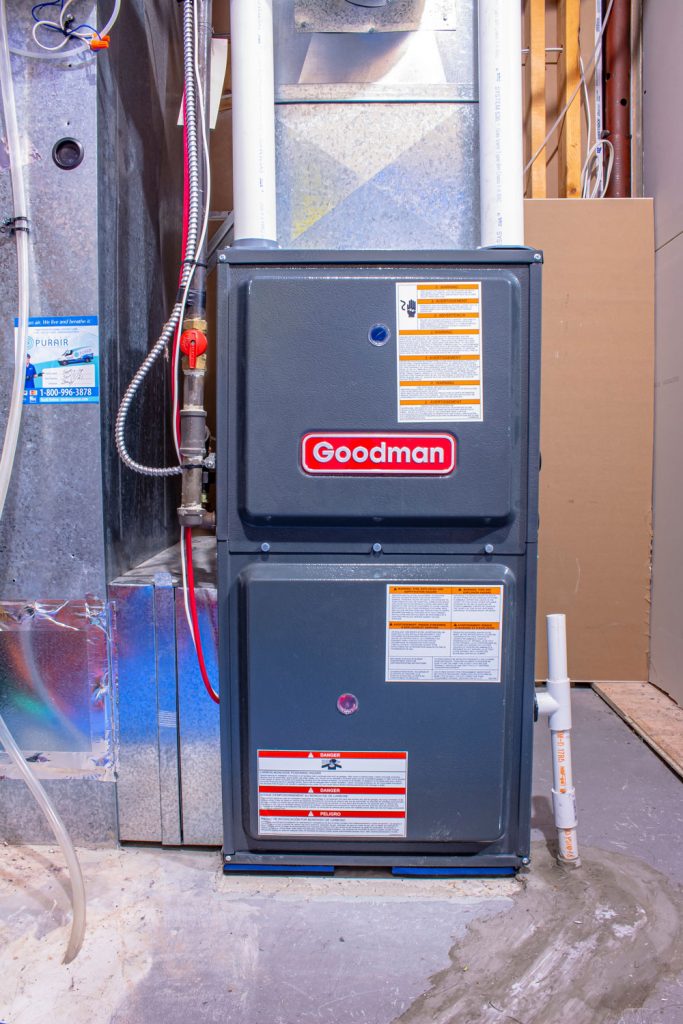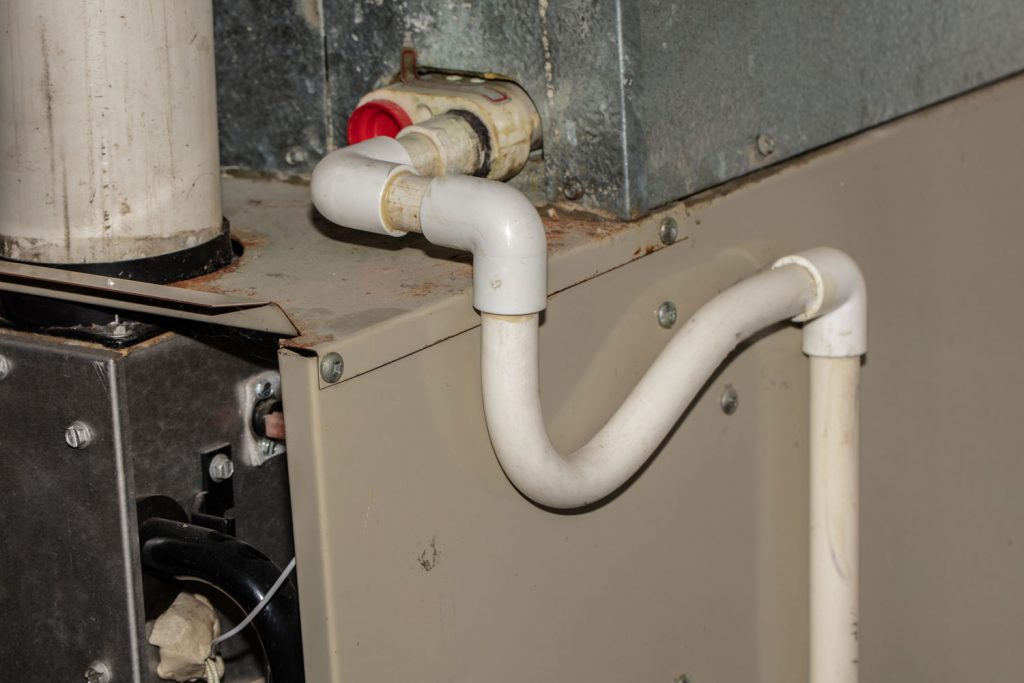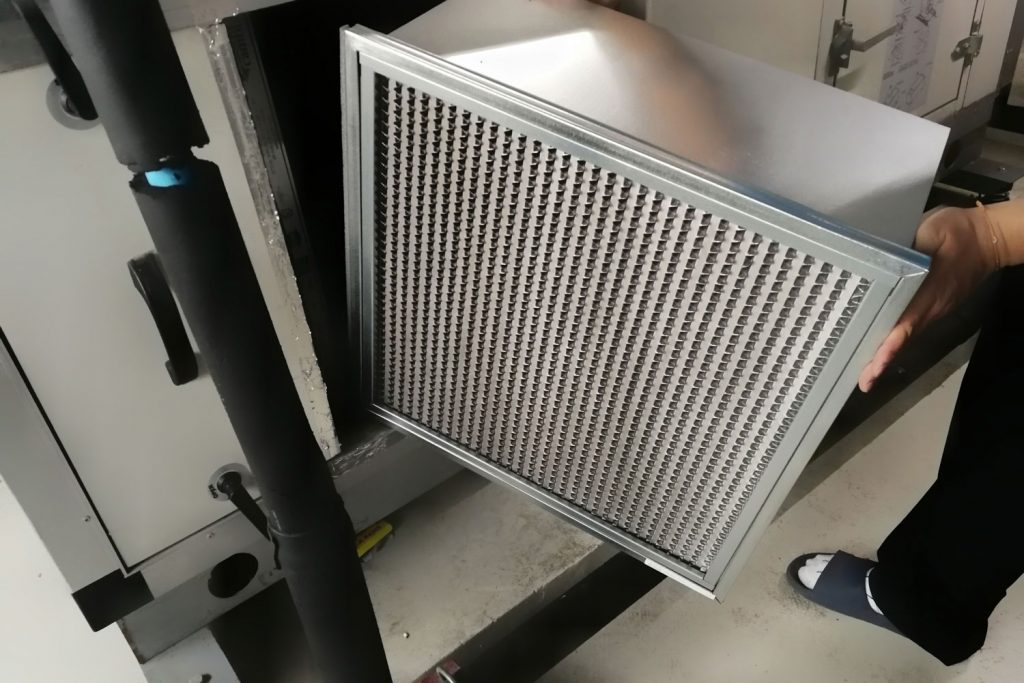High-efficiency furnaces generate a lot of condensation as they heat an interior space. The condensation must be drained to ensure that the furnace works properly. You may be wondering whether the furnace drain needs a trap. We researched the topic, and this is what we discovered.
The furnace drain in a high-efficiency furnace needs a trap to prevent a potential exhaust gas leak into the living space. The trap also keeps the inducer motor from sucking air through the drain. The position of the drain trap depends on the type of air handler you have installed.
Now that you understand a condensate trap is mandatory, keep reading to know whether it needs to be primed, how deep it should be, and where it is located in a high-efficiency furnace. Additionally, we will discuss if vents should be a necessary inclusion.

Where is the drain trap on a high-efficiency furnace?
The condensate drain trap in a high-efficiency furnace keeps air from moving in or out of the air handler or coil box during its operation. It is a compulsory component of the furnace drain as it aids in ensuring that your unit functions correctly.
Without a drain trap, you risk potential exhaust gas leaks into the living space. Moreover, the inducer motor would be thoroughly inefficient since it would draw air through the drain.

The positioning of the drain trap is largely dependent on the type of high-efficiency furnace installed. These traps use a portion of the condensate to avert air movement into or out of the equipment casing while still allowing the condensate to drain. Thus, they are located below the condensate pan.
Vertical Unit Drain Trap Location
In a vertical unit, the furnace is in an upright position. These units may be set up in the garage or a dedicated utility closet. Since the evaporator coils in a vertical component are stationed at the top, the condensate drain pan is just below these coils. The drain trap is positioned below the drain pan.
Horizontal Unit Drain Trap Location
A horizontal unit is installed on its side. It is often set up in places with limited space, such as an attic. In these units, air moves from side to side instead of up and down.
Thus, the evaporator coils are located beside the furnace or air handler near the return air ducts. The condensate pan is sandwiched between the evaporator coils above and the drain trap below.
Potential problems with drain traps
There are several downsides to a missing drain trap or improperly installing it. These include:
Little or no water in the drain trap
It is advisable to have enough water in a drain trap to enable the unit to function correctly. However, the trap may have insufficient water under the following circumstances:
- If the air pressure inside the unit is greater than that outside, there may be a geyser effect. As the condensate attempts to exit through a drain opening with the high-velocity incoming air, it might splash on the insulation, fans, and motors.
- If the pressure within a unit is greater than its surroundings, air escaping through a dried-out trap may carry the condensate as it exits due to high velocity.
- A siphoning effect resulting from washing the drain pan or water surging through the drain trap may result in dry outs and a loss of the water seal.
- If the minimum dimensional height requirements of the drain trap are not met, dry-out and air bypasses are common.
Freezing and Breaking
The end of the cooling season leaves more than enough water in the drain trap to carry over to the freezing season. This water fills the trap near the horizontal trap exit pipe.
The condensate might freeze when the pipe is exposed to the chilling winter air. Because frozen condensate takes up more space, it causes the pressure inside the pipe to increase, hence the pipe breaks.
If the broken traps are not promptly repaired, it may lead to dry-outs which may prevail, minimizing the unit's efficiency. Consequently, the costs of running the furnace may increase due to wasted energy.
Overflow of the drain pan
As the drain trap fills and dries in the course of operation, debris may accumulate in its bottom. If the drain trap is not properly maintained, the debris may accumulate over time, clogging the trap. As a result, the drain pan might overflow.
How deep should the condensate drain trap be?

The height of the condensate drain trap determines the possibility of the trap drying out. The unit's pressure system determines its trap size. Most high-efficiency furnaces have negative pressure systems, often called draw-thru units. In these units, the cooling coils are placed before the fan-blower section.
If the drain trap is too tall, negative pressure will prevent drainage, causing the condensate to back up into the system. This may result in property and equipment damage.
If the drain trap is too short, the negative pressure created at the system's startup will pull water from the trap into the air handler, destroying the seal. Consequently, you risk water carry-over to the ductwork, contaminated air, potential water back-up, and damaging the unit.
The required depth of draw-thru traps should have a minimum -between the bottom of the trap and that of the horizontal drain pipe exiting it- of two times the highest pressure of the water column expected within the air handling unit plenum at the drain.
Moreover, the differential height of the trap from its inlet to outlet should be at least one-inch water gauge more than the absolute static pressure of the unit.
Watch this video for a visual explanation of how deep the condensate drain trap should be:
Best practices for proper drainage
- Ensure a slight slope towards the drain to allow the condensate to flow naturally from the heat exchanger.
- Avoid double trapping and appropriately vent the drain after the trap to avoid airlocks.
- Ensure that the trap is clean and is examined at least four times a year. Check for any poor flow and rinse it to improve its functionality.
- Regularly inspect the drains and use flexible hoses for easy maintenance.
- Observe the regulations put in place by the local authorities, such as neutralizing the acidic condensate before draining.
Does the condensate trap need to be primed?
It is advisable to prime a condensate trap since it forestalls the trap from losing its water seal through evaporation. The water seal is integral to the proper operation of your unit as it prevents the backflow of combustion gases into the rooms where the units are installed.
To prime a condensate trap, you may do either of the following:
- Pour water into the trap before running the unit for the first time or after a long period of not running the appliance.
- Run the unit long enough to make sufficient condensate to fill the trap. It is advisable to avoid using the continuous fan setting until the trap is primed. The continuous fan impedes the condensate from flowing into the trap since the fan sucks the air back up the drain.
Does a condensate drain need a vent?

Typically, the manufacturer of a unit determines its configuration. It is advisable to vent the drain after the trap to avoid airlocks. The airlock may hinder the condensate from draining. Ensure that the ventilation pipes remain unobstructed at all times.
A high-efficiency furnace uses a venting system to extract heat before venting the residual corrosive condensate of carbon dioxide and water. Because this residual is highly acidic, it is advisable to use PVC pipes instead of metal pipes since the acidic residue would ruin standard venting equipment.
Side-wall Venting
Side-wall venting is an integral safety feature of high-efficiency furnaces. It requires setting up disjointed vent pipes horizontally so that they vent to the outdoors through a wall in your home.
It is advisable to separate the ventilation pipes from the furnace combustion chamber and be airtight to prevent flue gas leaks. Although you can use a vertical vent through the roof, this is not recommended due to maintenance challenges.
Concentric Venting
You may also employ concentric venting in place of side-wall venting in high-efficiency appliances. In this approach, two same-sized vent pipes are fitted together to a larger outer pipe that allows fresh air into the furnace and a smaller inner pipe that discharges exhaust gases outdoors.
If the high-efficiency furnace is not properly vented, you risk the possibility of residual carbon monoxide leaking back into your home. Moreover, the acidic exhaust can destroy an unprotected chimney's brick and mortar if it is improperly vented through the chimney.
Further, the exhaust can accumulate and freeze along with the chimney and chimney liner, thus damaging it.
Final Thoughts

The furnace drain needs a trap to facilitate the unit's proper functioning and ensure the safety of those living in a house by keeping flue gases from leaking into the living area.
It is important to note that a condensate trap requires proper maintenance and a keen adherence to the recommended industrial measurements for optimal performance.
You may also be interested in these topics:
How Efficient Is A 10-15 Year-Old Furnace?
Should Furnace Fan Be On Auto Or On (During Winter And Summer)
